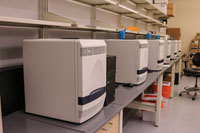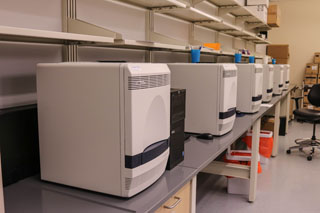
RT-PCR machines 320

Photo by Mallory Pfeifer/Texas A&M Veterinary Medical Diagnostic Laboratory
PCR machines such as these, which identify pathogens by detecting and amplifying specific genetic sequences from samples, are sitting idle in veterinary laboratories even as the U.S. struggles to enlarge its capacity to test for the virus that causes COVID-19.
Hundreds of machines in animal diagnostic laboratories across the U.S. are sitting idle when they could be used to test human samples for the virus that causes COVID-19, veterinary laboratory leaders say.
A shortage in testing for SARS-CoV-2 is widely considered the tallest hurdle in safely reopening the country and containing the pandemic. Several state governors are using testing capacity and availability as a key metric in deciding if and when businesses can reopen and people can return to their daily lives. But while pressure mounts to restart the economy, most states are still falling short in testing.
In an unprecedented move, a number of veterinary labs have taken steps to repurpose their well-equipped facilities, at least in part, to test samples from human patients for SARS-CoV-2. About half a dozen have been successful. Others have found the process hampered by regulatory restrictions. Despite President Donald Trump's assertion at a press briefing on Monday that his administration has "marshaled every resource at our nation's disposal" to battle the virus, animal labs remain largely untapped.
Dr. David Zeman, executive director of the American Association of Veterinary Laboratory Diagnosticians, said that because the equipment used in animal and human diagnostic labs is largely identical, the switch is easy from a logistical standpoint. "Facility-wise, there is no conversion," he said. "Laboratory safety guidelines and biocontainment protocols are pathogen-directed, not specimen-directed."
The difficulty lies in obtaining regulatory approval. "The lines and regulations in mammalian health have been clearly drawn between humans and all other animals," said Zeman. "Now drawn, crossing is complex — not from a scientific standpoint, but for authorization, regulation and liability."
Diagnostic testing is a major part of veterinary medicine. Every state has a high-capacity veterinary diagnostic lab, some of which routinely process hundreds of thousands of samples every year, largely from herds of livestock.
Dr. Bruce Akey

Photo courtesy of Dr. Bruce Akey
Texas A&M Veterinary Medical Diagnostic Laboratory Director Dr. Bruce Akey has the equipment and trained personnel available to significantly contribute to testing human samples for SARS-CoV-2, but is frustrated by inflexible federal rules.
"We're used to dealing with infectious disease on a population basis," said Dr. Bruce Akey, who directs the Texas A&M Veterinary Medical Diagnostic Laboratory. "A single house of chickens can be anywhere from 15,000 or 20,000 birds ... to upwards of a million birds. Technicians can go out and collect 100 or so samples for submission to us, and we know how to get that done in a hurry." These labs also are equipped to ramp up testing during an animal disease outbreak, such as avian influenza.
Akey believes high-capacity veterinary labs could make a significant contribution to COVID-19 testing efforts. "Across the U.S., these state-supported veterinary diagnostic labs, for something like African swine fever or foot-and-mouth disease, currently have a capacity of about 40,000 tests a day," he said.
Many economists and public health experts estimate that the country needs to test, at a minimum, a million samples daily, with some putting the number much higher, as high as 35 million per day. Instead, an average of fewer than 260,000 samples have been run each day during the past two weeks, although the figures are trending upward, according to The Atlantic’s COVID Tracking Project. With a capacity of 40,000 tests per day, veterinary labs could boost the numbers substantially — by roughly 15% if used at full capacity.
A laboratory that handles human samples must be certified by the Clinical Laboratory Improvement Amendments (CLIA), a program under the U.S. Department of Health and Human Services (HHS) that sets strict standards for labs that process human material.
In response to an inquiry from the VIN News Service, Nicole Black, a press officer for the Center for Medicare and Medicaid Services, the division of HHS that handles CLIA certification, said by email: "CMS is working closely with laboratories across the country to ensure that those seeking to perform COVID-19 testing can begin testing as quickly as possible. CMS is expediting review of applications for a CLIA certificate."
She added that after a laboratory has identified a qualified laboratory director and provided all the paperwork, it can immediately begin testing, as long as it meets "applicable CLIA requirements to ensure the accuracy of patient test results."
Partnerships smooth the way
By partnering with CLIA-certified laboratories run by states, private companies and medical centers, a handful of veterinary labs have managed to fast-track their certification process. Their help running human COVID-19 tests has reduced wait times for patients, and lab directors hope their participation will enable states to make the tests more broadly available.
The veterinary diagnostic lab at Colorado State University, for example, received the green light in mid-April to run COVID-19 tests on human samples, according to an article by the CSU College of Veterinary Medicine and Biological Sciences communications team.
The veterinary lab was able to expedite its CLIA certification by partnering with CSU's Health and Medical Center, which runs a CLIA-certified laboratory, the college news service reported. The veterinary lab also worked with the Colorado Department of Public Health and Environment to obtain human samples for validation testing, a step to ensure their tests worked.
The laboratory runs upwards of 600,000 animal tests per year. Adding COVID-19 to their repertoire was relatively straightforward, said the lab director Dr. Kristy Pabilonia. "We respond to animal disease outbreaks often," she said, according to the article. "What we do here on a daily basis uses the same processes and technology for animal testing as those used for human testing." The lab is now running 500 to 600 samples a day and could do more if needed, Pabilonia told the VIN News Service by email.
The Indiana Animal Disease Diagnostic Laboratory at Purdue University received CLIA approval in April after partnering with the Parkview Health System. It can run 400 samples per day without disrupting its testing of animal samples. "This number could be increased, if needed," the lab director, Dr. Kenitra Hendrix, said.
The veterinary lab at Oregon State University, which has a long history of tracking pathogens in sheep and cattle, teamed up with Willamette Valley Toxicology Laboratory, a private lab that runs drug tests on urine samples. Together, they are running several hundred samples a day, hope to process up to 2,000 samples daily and have the capacity for 3,000, according to director Dr. Mark Ackermann. Going full bore would more than double the daily testing reported by the Oregon Public Health Division, which averaged just over 2,000 cases a day last week, according to the state department's weekly report.
The Animal Disease Diagnostic Lab at Oklahoma State University, which, through a partnership with OSU Medicine, received CLIA approval at the end of March, also has the equipment to process more than 2,000 human tests per day, according to director Dr. Kenneth Sewell. "[We] are still ramping up our personnel to handle that many,” he said last week. "Our typical throughput is 1,000 to 1,200 per day." That is about one-third of what labs across Oklahoma are already testing, which state data shows is about 3,600 tests per average day over the past two weeks. The Washington Post reported Tuesday that the veterinary lab is now running more human coronavirus tests than any other lab in Oklahoma.
Separately, a SARS-CoV-2 test kit developed by a subsidiary of Maine-based Idexx Laboratories Inc., one of the largest veterinary diagnostic companies in the world, was approved last week by the U.S. Food and Drug Administration. Maine Gov. Janet Mills subsequently announced that the state would purchase enough of the test kits to more than triple its testing capacity, which was 2,000 tests per week. The samples will be processed not by Idexx, however, but at the Maine Center for Disease Control and Prevention's Health and Environmental Testing Laboratory in Augusta, according to the state announcement. The state will hire more lab staff to support the expansion.
A plea for regulatory flexibility
Taking advantage of high-throughput veterinary facilities during a pandemic may seem obvious. But while some labs have found the federal certification process relatively straightforward, others have met with what appears to be a lack of enthusiasm by authorities.
The Texas A&M diagnostic lab routinely processes 900,000 animal samples per year. Of those, 64,000 are tested using polymerase chain reaction (PCR), a common tool in both human and veterinary diagnostics that identifies specific pathogens in a sample by amplifying their genetic material. PCR is the standard technique used in COVID-19 tests.
After several weeks of appealing to federal officials at HHS, lab director Akey managed, through a partnership with a private health-care facility, to secure temporary CLIA certification for one of the lab's four locations. That location, in College Station, has the capacity to test 1,500 samples a day.
For the other three locations, which combined could double that capacity, Akey is stuck in red tape. Because those labs have not secured partnerships with human facilities, they have been denied certification to perform COVID-19 testing. HHS has been unwilling to bend its rules despite the extraordinary circumstances, Akey said.
"Every time we have one of these conversations, so far, all we have gotten is a further recitation of the existing regulations, chapter and verse, and no willingness to stretch anything," he said. "I don't think they've had to quite deal with something like this before."
CLIA establishes detailed educational requirements for every level of laboratory personnel, but the criteria do not include professionals in animal medicine, even though much of the expertise is the same. "They haven't been willing to accept equivalence for any of our veterinary degrees," Akey said. "For instance, one of our folks in molecular diagnostics has a PhD from the veterinary school here, and has been doing PCR testing for [some] 20 years. But her degree, being in veterinary science, is not considered adequate."
Furthermore, although Akey's personnel at College Station are experienced using the lab's high-throughput machines, they are not allowed to use them to process human samples, even with the lab's CLIA certification. Instead, they must train outside medical lab personnel.
"We've become a landlord, basically," Akey said. "We trained them, but we can't actually run the tests ourselves."
Moreover, personnel from human health-care facilities, which typically receive human samples in small quantities, are unaccustomed to using high-throughput machines, Akey said, noting that the visiting scientists ran approximately 200 samples in the first week. The number rose to about 700 last week, he said. By comparison, if the veterinary lab staff were allowed to use their own machines, he estimated that they could crank out some 500 samples per day without impinging on routine animal testing. "That wouldn't be a stretch for us at all," he said.
At Purdue in Indiana, Hendrix has faced a similar degree of bureaucracy, not to mention a puzzling lack of urgency. "The capacity we have dedicated to testing of human samples is being significantly underutilized," she said. "CLIA certification required paperwork and locating a 'medical director,' since none of us — DVMs, PhDs, certifications in a variety of specialties — qualified." But her staff — as well as those in Colorado, Oklahoma and Oregon — have been allowed to handle the samples themselves.
It is unclear why Hendrix and other lab directors were able to obtain approval for their staff to operate their own equipment while Akey was not. Like the others, Akey is working with a designated lab director with an MD who qualifies under CLIA. He suspects the explanation is a lack of coordination and standardization in the agency in dealing with an unfamiliar situation. "My guess would be that there are perhaps different interpretations or applications of the rules by different people within HHS," he speculated.
Black, the CMS press officer, did not explain why Akey's staff was disallowed from using their machines. She said only that "CMS is exercising enforcement discretion during the current public health emergency to respond to the urgent need to expand laboratory capacity."
Envisioning a new bridge across an old divide
Historically, a clear divide has existed between human and veterinary diagnostics. That dividing line was underscored after a tiger at the Bronx Zoo became the first nonhuman animal in the United States to test positive for SARS-CoV-2, in early April. News that a tiger could be tested for the virus while symptomatic people were having trouble obtaining tests prompted some public criticism. Officials from the zoo and government agencies stressed that veterinary and human medical laboratories are separate, and therefore, animal testing did not take resources from human testing.
Lyndsay Cole, assistant director of public affairs with the U.S. Department of Agriculture Animal and Plant Health Inspection Service, told Forbes in early April that regulatory restrictions prevent animal facilities from doing human tests altogether. "Samples from humans can't be tested at animal health laboratories, and likewise, tests from animals aren't tested at human health laboratories, so there is no competition for testing," she said, according to the article.
The paradigm may be changing. Some expect the COVID-19 crisis to help bring human and veterinary diagnostics under a single regulatory umbrella. "There should not be lines to separate the two," said Dr. Leyi Wang, a veterinary virologist at the University of Illinois College of Veterinary Medicine who was involved in testing the tiger sample. "After this crisis is over," he predicted hopefully, "the overlapping work and collaboration of the two kinds of labs will be strengthened."
Akey hopes that the pandemic will soon lead administrators at HHS to recognize the usefulness of veterinary labs in a crisis. "We all have quality assurance programs as part of the USDA's National Animal Health Laboratory Network," he said. "We're considered sufficient to test for high-impact animal diseases like avian influenza, which, by the way, is also a human-disease problem. So we're not some Johnny-Come-Lately working out of their garage."
He believes that the key lies in not seeing the world in black and white during an unprecedented situation. "By expanding the pool of people that are able to do the testing so that equipment isn't sitting there idle for 12 to 16 hours a day, I'm pretty sure that what is already available could be multiplied many times over," he said. "It just requires somebody to think a little bit outside the box."